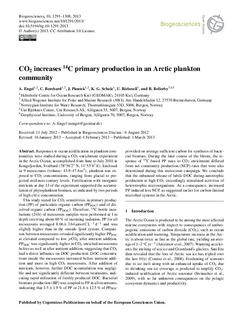| dc.contributor.author | Engel, Anja | |
| dc.contributor.author | Borchard, Corinna | |
| dc.contributor.author | Piontek, Judith | |
| dc.contributor.author | Schulz, Kai | |
| dc.contributor.author | Riebesell, Ulf | |
| dc.contributor.author | Bellerby, Richard | |
| dc.date.accessioned | 2014-02-27T11:03:59Z | |
| dc.date.accessioned | 2014-04-12T07:49:58Z | |
| dc.date.available | 2014-02-27T11:03:59Z | |
| dc.date.available | 2014-04-12T07:49:58Z | |
| dc.date.issued | 2013 | |
| dc.identifier.citation | Engel, A., Borchard, C., Piontek, J. et al. 2013. CO2 increases 14-C primary production in an Arctic plankton community. Biogeosciences 10(3) 1291-1308 DOI: 10.5194/bg-10-1291-2013 | nb_NO |
| dc.identifier.issn | 1726-4170 | |
| dc.identifier.uri | http://hdl.handle.net/11250/194282 | |
| dc.description.abstract | Responses to ocean acidification in plankton communities were studied during a CO2-enrichment experiment in the Arctic Ocean, accomplished from June to July 2010 in Kongsfjorden, Svalbard (78°56′ 2′′ N, 11°53′ 6′′ E). Enclosed in 9 mesocosms (volume: 43.9–47.6 m3), plankton was exposed to CO2 concentrations, ranging from glacial to projected mid-next-century levels. Fertilization with inorganic nutrients at day 13 of the experiment supported the accumulation of phytoplankton biomass, as indicated by two periods of high chl a concentration.
This study tested for CO2 sensitivities in primary production (PP) of particulate organic carbon (PPPOC) and of dissolved organic carbon (PPDOC). Therefore, 14C-bottle incubations (24 h) of mesocosm samples were performed at 1 m depth receiving about 60% of incoming radiation. PP for all mesocosms averaged 8.06 ± 3.64 μmol C L−1 d−1 and was slightly higher than in the outside fjord system. Comparison between mesocosms revealed significantly higher PPPOC at elevated compared to low pCO2 after nutrient addition. PPDOC was significantly higher in CO2-enriched mesocosms before as well as after nutrient addition, suggesting that CO2 had a direct influence on DOC production. DOC concentrations inside the mesocosms increased before nutrient addition and more in high CO2 mesocosms. After addition of nutrients, however, further DOC accumulation was negligible and not significantly different between treatments, indicating rapid utilization of freshly produced DOC. Bacterial biomass production (BP) was coupled to PP in all treatments, indicating that 3.5 ± 1.9% of PP or 21.6 ± 12.5% of PPDOC provided on average sufficient carbon for synthesis of bacterial biomass. During the later course of the bloom, the response of 14C-based PP rates to CO2 enrichment differed from net community production (NCP) rates that were also determined during this mesocosm campaign. We conclude that the enhanced release of labile DOC during autotrophic production at high CO2 exceedingly stimulated activities of heterotrophic microorganisms. As a consequence, increased PP induced less NCP, as suggested earlier for carbon-limited microbial systems in the Arctic. | nb_NO |
| dc.language.iso | eng | nb_NO |
| dc.publisher | European Geosciences Union | nb_NO |
| dc.rights.uri | https://creativecommons.org/licenses/by/3.0/ | |
| dc.title | CO2 increases C-14 primary production in an Arctic plankton community | nb_NO |
| dc.type | Journal article | nb_NO |
| dc.type | Peer reviewed | nb_NO |
| dc.date.updated | 2014-02-27T11:03:59Z | |
| dc.rights.holder | © Author(s) 2013. CC Attribution 3.0 License | |
| dc.subject.nsi | VDP::Matematikk og naturvitenskap: 400::Zoologiske og botaniske fag: 480::Økologi: 488 | |
| dc.subject.nsi | VDP::Mathematics and natural scienses: 400::Zoology and botany: 480::Ecology: 488 | |
| dc.source.pagenumber | 1291-1308 | nb_NO |
| dc.source.volume | 10 | nb_NO |
| dc.source.journal | Biogeosciences | nb_NO |
| dc.source.issue | 3 | nb_NO |
| dc.identifier.doi | 10.5194/bg-10-1291-2013 | |
| dc.identifier.cristin | 1036113 | |
| dc.rights.license | Creative Commons Attribution License 3.0 | |

